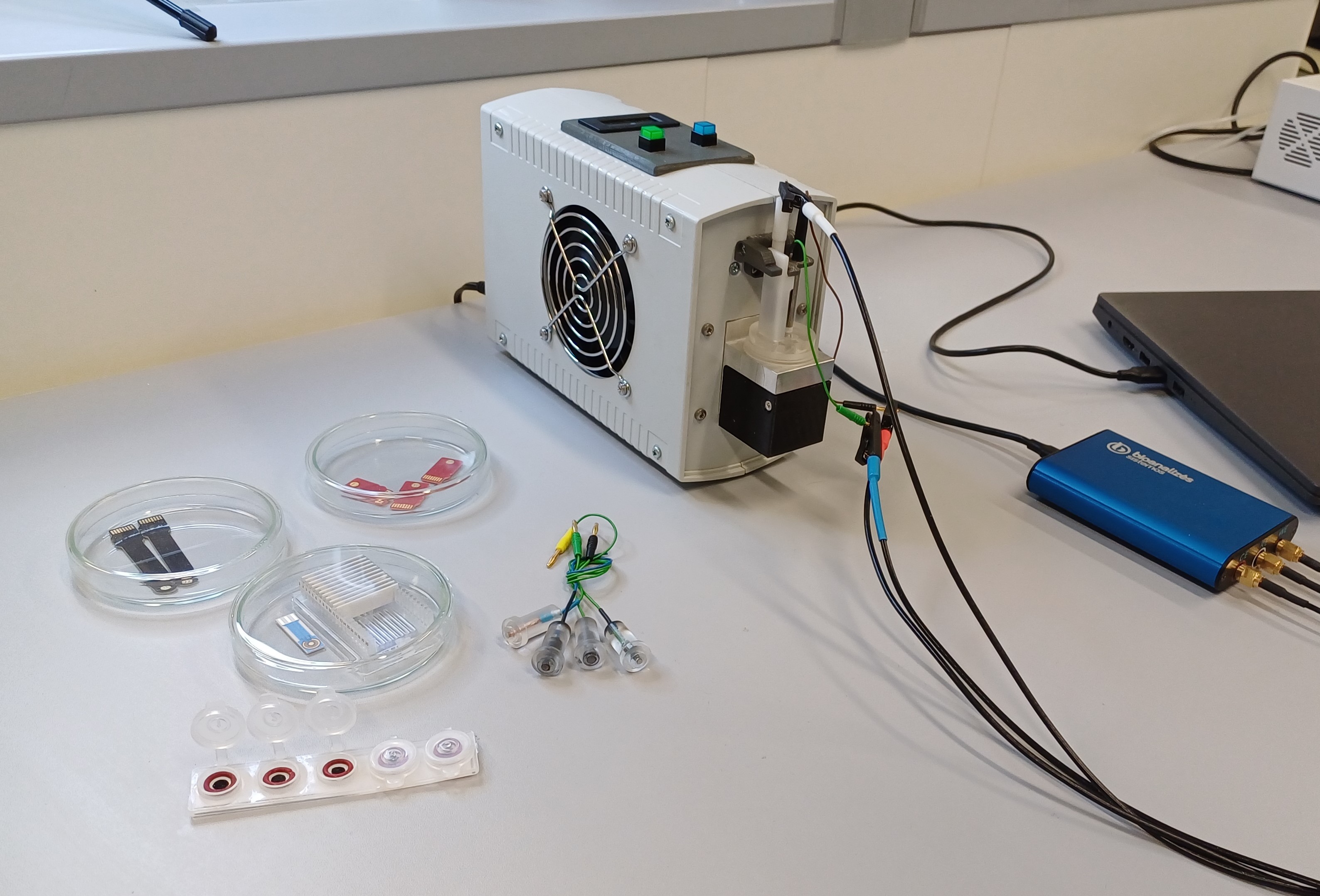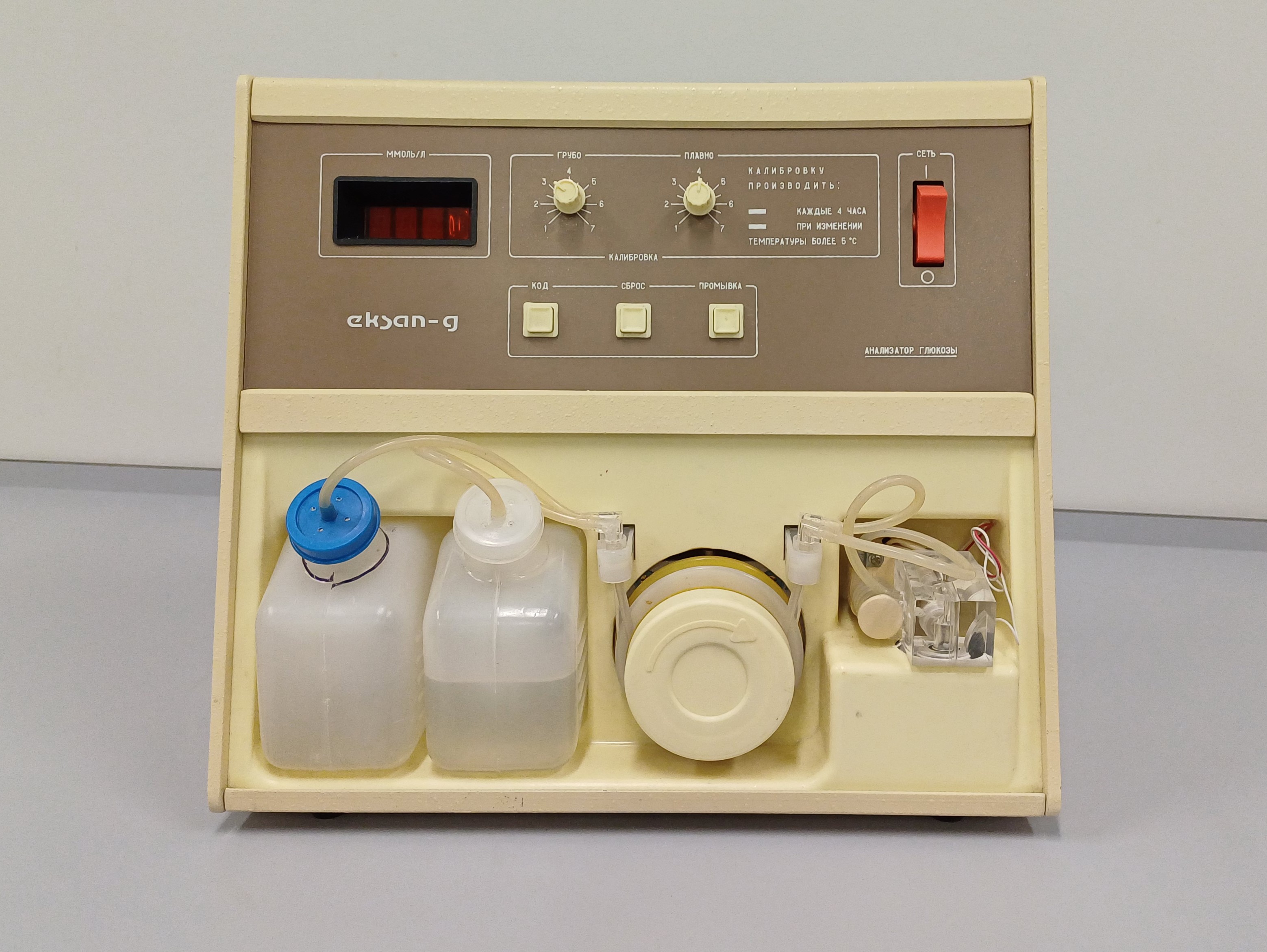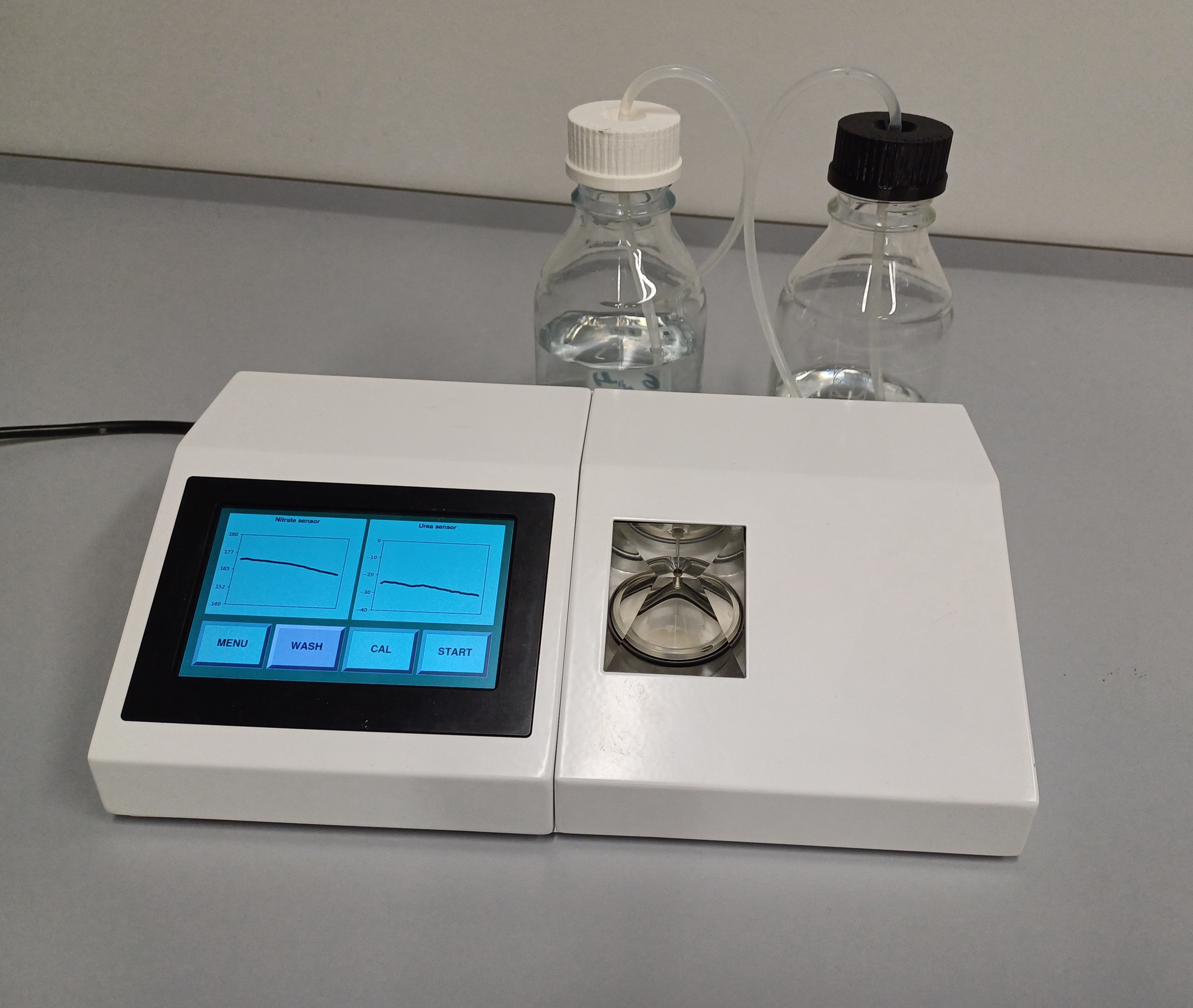Researchers are often approached by medical professionals or businessmen to solve challenges that they cannot solve on their own. Such requests are also received by the Bioanalysis Department of the Biochemistry Institute of the Life Sciences Center of Vilnius University, headed by Dr. Marius Dagys. According to the Head of the Department, biosensors developed by the team will soon appear in intensive care units, which will help patients in the hospital maintain vital functions. And this is just one example.
VU LSC researcher Dr. M. Dagys represents the field of biosensor research. His team is researching the fundamental properties of biosensors, while also looking for practical applications - the kind that doctors or entrepreneurs need most. According to him, the public is sometimes surprised when they learn what amazing things take place in laboratories.
The researcher talked about biosensors, how they are used in medicine, biotechnology, or the chemical industry, how Lithuania is doing in this field, and how he contributed to the internationalization of the country’s researchers.
Q: How do biosensors work and what do they detect?
A: By definition, they are analytical tools that have a biomolecule as an essential recognition component. It can be an enzyme that catalyzes a specific chemical reaction, it can be an antibody, or it can be a nucleic acid.
Our job is to recognize the reaction signal of that biomolecule, and there are several ways to do it. One of them is the electrochemical method, when, during the reaction, the device can record the specific current strength.
Q: And what are these reactions?
A: There are a lot of them. We know thousands of enzymes. For example, we have been interested in glucose for a long time. Glucose oxidase is an enzyme that catalyzes glucose oxidation while transferring the electrons to dissolved oxygen, resulting in the formation of hydrogen peroxide. The oxidation of hydrogen peroxide can be observed on the surface of a positively polarized platinum electrode by recording the strength of the so-called Faradaic current.

Membrane and disposable biosensor electrodes, autonomous electrochemical cell system
Q: Since you are also researching the application of biosensors, what kind of biosensors are we talking about? Why did you choose these?
A: Let’s start with fundamental and applied research. In general, we, researchers, are interested in how to connect the biomolecules I’ve mentioned to nanostructures, electrode surfaces, etc. How to do it efficiently without damaging the structure of the biomolecules so that they live longer to get a better specificity of the biosensor. We write scientific articles on findings of new enzymes, new analytes, new detection methods, etc.
But we also have an applied aspect. Our department is notable because, even during the Soviet occupation, we were the first in Eastern Europe, the third in the world, to commercialize a blood glucose analyzer.
Q: And what are those analyzers used for? Can blood glucose be determined in a laboratory? Are we talking about the ones that, for example, diabetics use to measure glucose spikes?
A: We are talking about laboratories. In those days, glucose was measured by long-lasting methods in clinics, etc. This is where you see the invention of our department. I was a kid when the researchers built it, and the machine still works!

Historical blood glucose analyzer "Eksan-G"
It measures glucose using the so-called amperometric principle. The electrodes and the electronics of the device are connected in such a way that a current proportional to the concentration of the substrate is observed. Other analogs of analyzers work on the potentiometric principle: when the current does not flow between the electrodes, and the potential differences between their surfaces are recorded. The latter method is sensitive to various contaminations, and backgrounds, and it is difficult to reliably produce electrodes in series, but it has been considered the gold standard since the 1980s. If only we then had a window to the world open…
The devices we develop are accurate and calibrated. In addition, the cost of one measurement comes to a few cents. That is, until the electrode in use “dies”, the only costs are essentially buffer solutions and blood sampling equipment. The permissible errors of our devices are small, no more than a few percent. Glucose strips, for example, can have a much larger margin of error, which is not good for prescribing insulin when a person might not need it at the time. People often come to us for a check-up - they get the results from the laboratory, and they check with us if the results match. There were quite a few of erroneous cases... Of course, the glucose machine mentioned is already historical, now we have created newer ones that we use. However, if necessary, this historical one would also work (smiles).
Q: Let’s go back to the other biosensors in your lab. What other applications are we talking about besides blood glucose measurements?
A: What else we measure - urea. This is a compound that is the main end product of nitrogen metabolism and accumulates in the body, and if kidney function is impaired, the patient needs dialysis. There is no such mobile device that directly measures the concentration of urea in the blood. There are dialysis machine attachments that measure urea in dialysis fluid using a spectrophotometric cell, but not directly in the blood. We also have a two-parameter device that additionally measures creatinine.
There is a procedure called peritoneal dialysis, which is performed at home. However, it is not suitable for everyone, as the patient’s heart must be strong, and the patient cannot have complications or additional aggravating circumstances. As the number of people grows, and not necessarily the number of doctors, remote medicine will become more and more relevant. A bedside device that can show how well the blood has cleared after an overnight stay will be of great value.
The next device we are developing will soon be in hospitals, next to patient beds in the intensive care unit. This is a device for determining the amount of amino acids and urea in the blood. Its idea was born after talking with doctors from Vilnius University hospital Santaros klinikos. We are talking about patients who are lying unconscious, possibly for days. They can’t eat, so they need an aided protein introduction. The question is how much protein do you need?
The doctors told us that to solve the problem they needed a machine that could measure the total amount of L-amino acids in the blood. We discovered the necessary enzyme, and developed a membrane electrode that reacts to all main amino acids. We are developing an according device with which we can obtain the total amount of amino acids in the blood, and then the doctors will know exactly what kind of drip to prepare for the patient, and what they are lacking. No need to guess.
Q: Doctors, for example, from Vilnius University hospital Santaros klinikos present you with a real problem, and then, in this laboratory, you look for ways to help doctors and, of course, patients?
A: Yes, that is often the case.

Analyzer for two parameters (urea and nitrate)
Q: In your laboratory, biosensors were also developed that could help control the pandemic. Can you tell us more about it?
A: When the pandemic started, it was a surprise to many, including us, in the world of biosensors. I mean, there was no commercial virus analyzer, there was no market need for it. There were only RT-PCR and strip tests, but it was not enough. This is where all the biosensor researchers in the world got off to a crouch start. We have also developed our own COVID-19 infection sensor that works with real saliva samples. Its principle of operation is to detect a specific sequence of viral RNA on the surfaces of disposable gold electrodes. Although gold sounds expensive, it’s actually only needed for a very thin layer, so it’s not that expensive.
A single-stranded nucleic acid corresponding to the sequence of the spike protein of the virus is anchored on the sensor of the SARS-CoV-2 virus - a nanostructured electrode. The idea is that we put the sample in a tube that contains a buffer liquid that breaks down the virus, and then we introduce it into the medium on the electrode, and the electronic system immediately sees whether the sequence we’re looking for “sticks” to the functionalized surface.
We’ve been working on it, but the market eventually became oversaturated with coronavirus tests. We have improved our system, i.e. we repurposed the method. There are such enzymes as nucleases. There is a problem if biotech products become contaminated with them, for example, if they get from contaminated surfaces into product tubes, the customer gets a degraded oligonucleotide. So, we developed a nuclease activity sensor that can help biotech companies avoid that contamination.
Q: Do company representatives often contact you with problems they ask for help in solving?
A: For example, we met the representatives of AB Achema, who needed to analyze fertilizers. They produce urea as a component of nitrogen fertilizers. Its concentration in fertilizers is very important for the company because customers expect to receive no less urea than is written in the product composition. To protect against errors in the production process, the manufacturer adds a little more urea, which costs money. Therefore, we are completing the development of a fertilizer analyzer that measures not only urea, but also all forms of nitrogen in liquid fertilizers, and we hope that accurate measurement with this device will allow the company to add less excess material to the product.
So, we work with medicine, biotechnology, as well as with the chemical industry.
Q: Let’s return a little to medicine, to the diagnosis and monitoring of diseases. What other biosensors are worth mentioning?
A: The advantage offered by biosensors is fast measurement at a specific location. In one of the James Bond movies, Casino Royale, there was a scene in which agent Bond was playing poker and was poisoned. He managed to get into his car and inserted a needle sensor into his vein, which sent the data to his agency, where specialists analyzed what kind of poison the agent had taken. It was a biosensor! It is possible to create such one in reality, but it is needed only for a very narrow market and thus would be very expensive. However, it was perfect for a fictional intelligence agency.
With Russia’s war in Ukraine in mind, the military industry is also relevant for us. For example, we are developing a biosensor that can monitor blood inflammation, whether the injured person’s body is not infected, and whether drugs need to be given. It can be paired with, for example, a glucose or amino acid biosensor into a single device used in extreme conditions. We are highly motivated, we have all the necessary competencies in the department: biochemists, engineers, electricians, programmers, etc.
Q: What challenges do you face as a researcher in your field?
A: As an example, we can cite the history of the best-ranked article from our laboratory so far (impact factor 33). We also work in a field called biofuel cells. A biofuel cell is like biosensor – when implanted in the body it can generate electrical current for microdevices from glucose and oxygen in the blood. Preferably as high as possible. For biosensors, substrate specificity is more important, while for biofuel cells, it’s all about the power densities achieved. One of the electrodes (higher potential) is oxygen-driven.
The problem is that there is not much oxygen in the blood, and it is necessary to “extract” the available electrochemical energy from each oxygen molecule as efficiently as possible. We discovered an enzyme that we oriented on the surface so that it could reduce oxygen efficiently with only one of the two available active centers. We wrote a paper and sent it for publication to a high-ranking journal, but it was rejected. Of course, we didn’t get discouraged and decided to send it to an even better one. A review came from it, in which, among other comments, the reviewers asked us to “turn” that enzyme back and perform measurements, and the time they gave us was like three weeks. And we did it! Moreover, the essential research was cheap, done with basically three electrodes.
The moral of the story - research projects need not so much of funds, but more importantly the freedom of action. Because you know little about how and what kind of result you will get, and a goal worth the effort can change very quickly.
Q: Perhaps this is especially relevant in fundamental research that expands our understanding?
A: Yes. All over Europe, freedom is given in research projects, however, in Lithuania not so much. In essence, we must plan everything in advance. There is such a practice abroad: you describe an idea, experts evaluate it, and you get funding – that’s it, do your research as you see fit, and good luck. In our country, that freedom is somewhat restricted, for example, by the rules of structural funds. According to those rules, research is viewed as the construction of a house: you need a certain number of bricks and tiles, if you want to change something, you must write why you made a bad prediction. Therefore, even fundamental research, which can be unpredictable, must be planned.
Q: Biotechnologies and lasers are very strong fields of research in Lithuania. Since you work in biotech, what do you think should be highlighted?
A: As much as I traveled abroad, and as much experience as I had, Lithuanians, as a nation, are valued for their intelligence, hard work, and dutifulness – no one can take this away from us. We also have a dynamic startup ecosystem - researchers are also taught how to set up startups. It takes the wind out of our sails because we start doing things we don’t know how to do (laughs). However, the state encourages consulting with entrepreneurs, there are heaps of training, everything is basically free, and you can also get legal help. We have also founded a startup. There may be a few startups that fail, but one will definitely succeed, and it will take the entire sector forward. It is very important that Lithuanians undertake it.
On the other hand, I sometimes wonder why politicians don’t come to laboratories more often, even to take pictures for election flyers. Maybe research is not as popular as the issue of raising pensions, but we could certainly show what we can be proud of. Instead, I’m glad that curious people come and want to learn more. For example, Gabrielius Liaudanskas-Svaras (a famous rapper-turned-member of the Lithuanian National Defense Volunteer Forces) visited together with the “Contribee” community he has founded (best wishes). Schoolchildren also come, and we let them try the devices themselves. Everyone is amazed at how many different things we do here. And I’m glad that it’s appreciated, and that the public is interested to see.
Q: Your contribution to biotechnology is also very important. You’ve been featured in the prestigious ACS Sensors journal. How did you manage to do that?
A: Yes, it is very difficult to get there. We managed to do this together with my colleagues from Malmö University (Sweden) and the Lithuanian professor Tautgirdas Ruzgas who works there and was my mentor during my doctoral studies.
We handed over to them an enzyme, which is extremely stable on a surface, developed by our colleagues and tested by us - membranous glucose dehydrogenase - and we helped connect it to a nanostructured gold electrode. Swedish colleagues then developed a wireless glucose sensor that works, for example, on the skin, and it can send data using the RFID principle via an antenna to a remote recorder. We managed to publish the results in ACS Sensors, the highest-level journal in the field of analytical chemistry in the world, and we became the third group of Lithuanian authors who managed to do so. Later that year, we managed to publish another invention in this journal describing the previously mentioned L-amino acid biosensor, the authors of which were, for the first time in history, exclusively Lithuanians, employees of our Bioanalysis Department. It is very difficult to be published in such journals, but if some researchers succeed, then it is a well-trodden path for others. Probably, from now on it will be really easier for Lithuanians to be published in that journal.
Q: Thank you for the conversation!
A: Thank you too.
Interviewed by Goda Raibytė-Aleksa
Photo credits: M. Dagys personal archive
